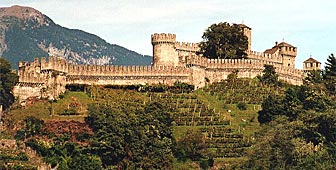Unesco World Heritage committee adds Swiss site to list

The United Nations' World Heritage committee has added three medieval fortresses in southern Switzerland to its list of sites of "outstanding universal value".
The castles in Bellinzona were declared a World Heritage Site at a meeting of the committee in Australia. They are among 71 natural and cultural sites nominated this week for inclusion on Unesco’s list, which counts 630 sites worldwide.
The decision is recognition that the castles represent a unique example of medieval military architecture.
Built in the 15th century across the entrance to several valleys in the Ticino region, the complex controlled access to several Alpine passes on one of the most important North-South trading routes in Europe.
The vote in favour of Bellinzona’s castles brings to four the number of World Heritage sites in Switzerland. The others, all included in 1983, are the Old City of Bern, the Abbey of St Gallen, and the Benedictine Convent of St John at Müstair.
Despite Switzerland’s reputation as a country of outstanding natural beauty, not one of its natural sites appears on the World Heritage List. An application to place Europe’s longest glacier, the Aletsch, on the list will be considered next year.
The World Heritage List was established under the terms of a convention on protecting the world’s natural and cultural heritage, which was adopted by Unesco’s member states in 1972. More than 160 countries have signed the convention.
To be included, sites must be of outstanding universal value, a definition which leaves the World Heritage Committee with considerable room for manoeuvre.
In practice, a cultural site may be added if it is considered to be a masterpiece of creative genius, to have exerted great architectural influence, is associated with beliefs of universal significance or is an outstanding example of a particular way of life.
Natural sites must exemplify major stages in the earth’s history, contain natural habitats of endangered creatures, or simply be a scene of exceptional beauty.
Inclusion on the list can be an asset for tourism, but it also commits countries to protecting their heritage.
by Malcolm Shearmur

In compliance with the JTI standards
More: SWI swissinfo.ch certified by the Journalism Trust Initiative
You can find an overview of ongoing debates with our journalists here . Please join us!
If you want to start a conversation about a topic raised in this article or want to report factual errors, email us at english@swissinfo.ch.